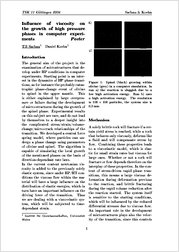| dc.contributor.author | Sachau, Till | |
| dc.contributor.author | Koehn, Daniel | |
| dc.contributor.editor | Philipp, Sonja | |
| dc.contributor.editor | Leiss, Bernd | |
| dc.contributor.editor | Vollbrecht, Axel | |
| dc.contributor.editor | Tanner, David | |
| dc.contributor.editor | Gudmundsson, Agust | |
| dc.date.accessioned | 2010-11-26T13:21:28Z | |
| dc.date.accessioned | 2013-01-28T10:20:34Z | |
| dc.date.available | 2010-11-26T13:21:28Z | |
| dc.date.available | 2013-01-28T10:20:34Z | |
| dc.date.issued | 2006-03 | |
| dc.identifier.citation | Philipp, S.; Leiss, B; Vollbrecht, A.; Tanner, D.; Gudmundsson, A. (eds.): 11. Symposium "Tektonik, Struktur- und Kristallingeologie"; 2006, Univ.-Verl. Göttingen, p. 187 - 188. | |
| dc.identifier.isbn | 3-938616-40-7 | |
| dc.identifier.uri | http://hdl.handle.net/11858/00-1735-0000-0001-345E-7 | |
| dc.description.abstract | The general aim of the project is the
examination of microstructures that develop
under HP conditions in computer
experiments. Starting point is an interest
in the dynamics of HP phase transitions,
as for instance the probably catastrophic
phase-change event of olivine
to spinel in the upper mantle. This
is either explained by large overpressure
or failure during the development
of micro-structures during the growth of
the spinel phase. Experimental results
on this subject are rare, and do not lead
by themselves to a deeper insight into the complicated stress/strain/volumechange/
micro-crack relationships of the
transition. We developed a central force
spring model, where particles can undergo
a phase change using parameters
of olivine and spinel. The algorithm is
capable of simulating the local growth
of the mentioned phases on the basis of
direction-dependant rate laws.
In the current context newtonian viscosity
is added to the previously solely
elastic system, since under HP/HT conditions
the viscous flow within the material
will have a large influence on the
distribution of elastic energies, which in
turn have an important influence on the
driving force of the transition. Thus
we are dealing with a visco-elastic system,
which will be subjected to timedependant
strain. | |
| dc.format.mimetype | application/pdf | |
| dc.language.iso | deu | |
| dc.publisher | Universitätsverlag Göttingen | |
| dc.relation.ispartof | 11. Symposium "Tektonik, Struktur- und Kristallingeologie" | |
| dc.subject.ddc | 551 | |
| dc.subject.gok | VKA 200 | |
| dc.subject.gok | VBE 000 | |
| dc.subject.gok | VKA 110 | |
| dc.subject.gok | VAE 120 | |
| dc.title | Influence of viscosity on growth of high pressure phases in computer experiments | |
| dc.type | anthologyArticle | |
| dc.subject.gokverbal | Gefügekunde der Gesteine | |
| dc.subject.gokverbal | Modellierung von Prozessen in der Geosphäre | |
| dc.subject.gokverbal | Gesteinsbestimmung | |
| dc.subject.gokverbal | Methodik {Strukturgeologie} | |
| dc.bibliographicCitation.firstPage | 187 | |
| dc.bibliographicCitation.lastPage | 188 | |
| dc.identifier.doi | 10.23689/fidgeo-1902 | |
| dc.type.version | publishedVersion | |
| dc.subject.free | Hochdruckparagenese | |
| dc.subject.free | Viskosität | |
| dc.subject.free | Olivin | |
| dc.subject.free | Spinell | |
| dc.subject.free | Kristallisation | |
| dc.subject.free | Computersimulation | |
| dc.relation.collection | Geologische Wissenschaften | |
| dc.description.type | conference | |


